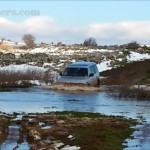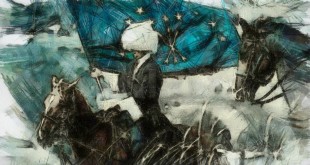After two snowy off-road trips to Golan Heights, we couldn’t pass the opportunity of a third consecutive snowy weekend, this winter brought. After inquiring about blocked routes, the path up the Golan Heights, which had numerous Adyghe villages, was chosen.
“The first permanent settlers of the Golan Heights in the modern era”
The destination was Beshanit ridge, formed by volcanic activities, providing scenic viewpoints. We’ve passed Khushniya, which is quite prominent due to mosque ruins left standing near the main road, and headed north. We got off the road eastward just before Alonei-Habashan on a dirt road covered by snow and crossed the ruins of former Adyghe village Juwezah, that like Khushniya, was one of thirteen Adyghe/Circassian settlements on the Golan Heights. The last are described as “The first permanent settlers of the Golan Heights in the modern era” (Kipnis, 2013).
How Adyghes got to the Golan Heights
In the late 19th century, the Adyghes were deported from their homeland, located in Northwest Caucasus, after a skillful and audacious fight, that lasted over a century, against the huge army of the Russian Czar, who coveted their land and invaded it. The Ottoman Empire absorbed the banished Adyghes and dispersed them in its frontiers, utilizing their loyalty, fighting skills and courage, to impose rule and order in troubled regions. Placing them on the Golan Heights resulted in the desired outcome and within a short period of time, thirteen Adyghe villages were established. One of which evolved over the years into a mixed and major city, Quneitra. For further reading on the Golan Adyghes, please see the studies by Gottlieb Schumacher, Adib Souleiman Bagh and, Yigal Kipnis.
Gottlieb Schumacher Adib Souleiman Bagh Yigal Kipnis
First Coffee Break
“A sounder (group) of wild boar at one o’clock!” Echoed from the radio (walkie-talkie). Indeed, as we turned our eyes slightly to the right, there was a large group of wild boars searching for food in the snow. We continued eastward to Samkat hill, standing at 1,018 meters above sea level, for our first coffee break. After tasting the scenery and filling our lungs with clear and chili air, we got back on the tools and headed for Hazeka hill/mount Hozek. We continued climbing towards Mount Kortam and after dealing with quite a slippery slope due to snow, on the western slopes of Mount Kortam, we steered north towards Mount Benei-Rasan. Also called Tel Mumsiya after the ruined village at its foot, which was too one of the thirteen Adyghe villages in the Golan Heights.
Deceptive Tranquility
 After a short break near the wind turbines at the summit, we continued north towards Tel Ein-Ziwan and at its foot, we headed east towards the ruins of Surman. Like those aforementioned, Surman was also an Adyghe village. A beautiful mosque erects at its center, built from basalt, with chiseled stone stairs that lead you swirling up, to the top of the turret.
After a short break near the wind turbines at the summit, we continued north towards Tel Ein-Ziwan and at its foot, we headed east towards the ruins of Surman. Like those aforementioned, Surman was also an Adyghe village. A beautiful mosque erects at its center, built from basalt, with chiseled stone stairs that lead you swirling up, to the top of the turret.
Local Adyghes are familiar with the history of Golan Heights Circassians and the ruins of the mosque in Khushniya became an informal monument. But this was our first time to visit Surman. The view revealed from the minaret displayed carpets of snow covering the Syrian side with deceptive tranquility. This was interrupted quite soon by the noise of shells being fired occasionally, across the border. Looking north you could see mount “Hermon” / “Sheikh” covered with white, standing proudly, protruding over the rest.
Carefully walking, while paying close attention to warning signs from mines, we crossed the village north closer to the border. Looking across the border, we saw some vehicles movement in Mudiriya. Another former Adyghean settlement, which became a mixed town over time, like Quneitra.
Ein-Ziwan before heading home
 From Surman, we got back on the highway and headed south. After about a mile and a half, we turned west to a muddy road passing south of Ein-Ziwan ruins. By now, it’s probably obvious to the reader that Ein-Ziwan was also an Adyghean village. The road was covered with muddy snow and water ponds formed from melting snow.
From Surman, we got back on the highway and headed south. After about a mile and a half, we turned west to a muddy road passing south of Ein-Ziwan ruins. By now, it’s probably obvious to the reader that Ein-Ziwan was also an Adyghean village. The road was covered with muddy snow and water ponds formed from melting snow.
As we got back to the highway, we filled the pickup bed with snow for the kids. Unlike previous times, this weekend they chose to stay home. When traffic congestion began to form, we cut south to the Petroleum road. It is inaccessible to regular traffic because of poor road quality. A short while after, we joined the main road and from there, the road home was clear.
 Adiga Riders Adige Offroad site – Horses, 4wd and mountain bikes
Adiga Riders Adige Offroad site – Horses, 4wd and mountain bikes
